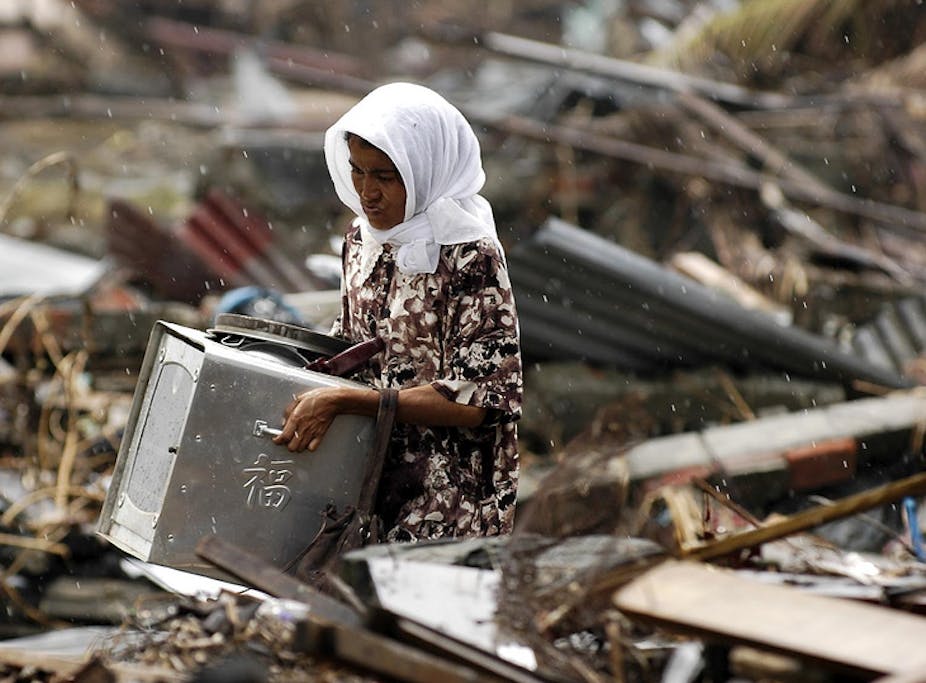The Philippines. Pakistan. New Orleans. Sri Lanka. All have suffered catastrophic disasters in recent times. And the emergence of “climate refugees” – populations displaced by extreme weather events – is now a well-documented phenomenon.
Many developing countries are particularly vulnerable to natural disasters such as floods, tsunamis, and earthquakes. And like many human and natural disasters, extreme weather events affect certain populations disparately and unfairly. Not only are extreme events more likely to affect particular communities in naturally vulnerable geographic locations – such as small Pacific islands – but some people also tend to come out worst.
Typhoon Haiyan, for example, devastated some of the most impoverished regions of the Philippines, such as the Eastern Visayas, where families living in poverty were (and still are) especially vulnerable to loss of livelihood with no material or financial resources to fall back on.
Even in developed countries such as the US, with relatively robust infrastructure and social systems, an extreme climate event can affect certain members of the community unequally. Hurricane Katrina was a stark example of how a natural disaster can split a region into haves and have-nots. Poor and marginalised groups such as women, the elderly, people with a disability and those from ethnic minorities in New Orleans experienced unfair allocation of resources (or sometimes none at all) and bore a disproportionate burden of suffering.
During the disaster
Women are particularly vulnerable when it comes to humanitarian or natural disasters, yet issues relating to their specific needs tend to be overlooked or excluded as a disaster unfolds.
Women are far more likely to be injured or die than men – estimates suggest three times as many women than men died in the 2004 Boxing Day tsunami in Asia. Why? Because women are more likely in some cultures to wear clothing that is heavy and overly restraining; have long hair that is more likely to get tangled in debris; and have a lack of education on how to swim. It may even come down to a choice of saving a male family member over a female. These have all been identified as factors that are dangerous and sometimes deadly to women.
Women also don’t receive necessary healthcare; specific care, such as for pregnant women, isn’t often a consideration during the relief effort, which is often also a male-dominated affair. It is estimated that 150,000 women were pregnant when the Asian tsunami struck in 2004, of which 50,000 were in their third trimester. Yet a lack of access to obstetric care leaves women at risk of miscarriage or complications, made worse by poor sanitation.
In areas that didn’t have these services before the disaster (in pre-Tsunami Banda Ache, for example, only two thirds of all births were attended by skilled health personnel), the loss of midwives and healthcare infrastructure only makes the situation worse.
After the disaster
Disasters interrupt the most fundamental of community processes and resources. Communities are often physically displaced, seeking shelter in temporary accommodation or refugee camps, where conditions can be overcrowded and lack food and basic sanitation.
For women, new dangers include sexual violence and sexually transmitted infections. And in the chaos and displacement that is the aftermath of a natural disaster, child abuse and neglect, violence against a partner, and exploitation and trafficking are likely to increase. Following the Mt Pinatubo eruption in the Philippines, Hurricane Mitch in Nicaragua, and the Loma Prieta Earthquake in the US, the WHO reported that intimate partner violence signficantly increased. Likewise, reports from the Sri Lanka and Indonesia following the Asian Tsunami focused on concerns over the protection of women from sexual violence.
In the recovery after a major natural disaster, women are often the first to mobilise. According to a report from the Global Fund For Women, Guatemalan women took over the traditionally masculine tasks of rebuilding homes and digging wells following the devastation of Hurricane Mitch. Up to 70% of all local organisations involved in the rebuilding processes in Banda Aceh following the Asian tsunami were women’s organisations or mainly staffed by women.
But despite their efforts, women are often marginalised or excluded from the decisions made about a disaster and the policies that follow leaving them to ongoing economic and social vulnerability. On top of this they also have the double-burden of family duties and caring, and providing financially for the family in the event of the loss of males. Disturbingly, some men are known to abandon families and use relief aid for themselves, and this has been observed in Miami, Bangladesh, the Caribbean and Brazil following natural disasters.
Lower literacy levels and lack of land ownership also place women in an economically vulnerable position and can be a factor in pushing women into prostitution and positions of exploitation.
What next?
The Global Fund For Women and the Women’s Refugee Commission have suggested that active measures put in place to respond to sexual violence. Women’s reproductive health needs, such as contraception and basic obstetric care need to be accounted for and women’s livelihoods need to be promoted through programmes to help survivors re-establish a sustainable income. This will have downstream effects on the health and well-being of the entire family and protect girls and women from situations of exploitation and trafficking.
The needs of women during a natural disaster don’t simply begin and end within the disaster itself – they play out long after the event. Women need to be recognised in all the decision making, from planning, provision and evaluation of aid services if problems are to be prevented from happening or spiralling once the actual disaster has passed.

